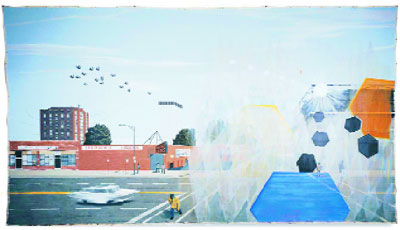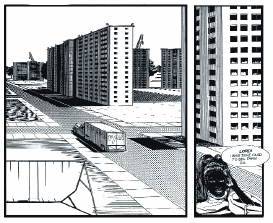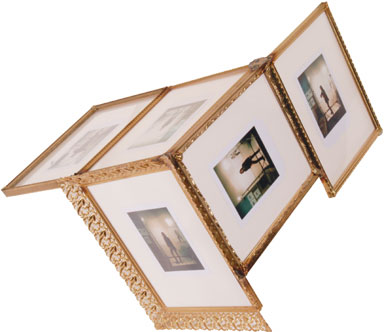
By Rael Salley
In these days of uncertainty, it surely
would be comforting to have a grasp of one true thing. After
all, our environment is still deteriorating, unemployment
rates are still high (despite the optimism of recent surveys),
and thwarting, combating and/or punishing acts of terrorism
are daily concerns in the United States. It is a good thing
the whole “race thing” has taken a backseat. After
all, the major problem in the U.S. is no longer “the
color line,” as W.E.B. DuBois asserted. Dark-skinned
people are still harassed and incarcerated at alarming rates,
but hip-hop is now mainstream music, so all’s well.
The Civil Rights movement is now history. Dark-skinned actors,
athletes, and entertainers are on television constantly, so
the failure of public school education in inner cities —
where a major percentage of the citizenry is Black or Hispanic
— is overlooked, and no longer registers as a major
issue. The “art world,” the term that often refers
to an amalgam of artists, art dealers, and art collectors,
now has its stable of established “Black” artists
that can be called upon to assert the identity politics that
will surely “spice-up” any exhibition. This way,
galleries, museums and other art-oriented organizations simultaneously
avert cries of discrimination and pull in patrons from diverse
ethnic backgrounds. I am being ironic to highlight a trend.
Essentializing petty issues into bite-sized, digestible pieces,
while exaggerating to make them seem poignant, has become
a staple of everyday life — even artistic life.
 It
is in this climate that the Museum of Contemporary Art (MCA)
in Chicago presents Kerry James Marshall’s One True
Thing: Meditations on Black Aesthetics. The title implies
a presentation of, or at least a quest for, certainty. But
upon entering the exhibition space, a viewer can quickly apprehend
irony in the heading. Marshall presents painting, photographs,
video, sculpture, and installation. The media overlap and
intertwine, presenting the viewer with complex visual problems.
The conundrums continue as viewers encounter the work of guest
artists; works embedded in Marshall’s show that offset
traditional ideas of a “solo” show. The works
operate on a multitude of visual levels, and Marshall attempts
to address concerns inherent in each medium. It is only after
the encounter with visual complexity that one can begin to
peel layers of conceptual intent, and begin to wonder: ”What
is the relationship between all of these diverse creations?”
It
is in this climate that the Museum of Contemporary Art (MCA)
in Chicago presents Kerry James Marshall’s One True
Thing: Meditations on Black Aesthetics. The title implies
a presentation of, or at least a quest for, certainty. But
upon entering the exhibition space, a viewer can quickly apprehend
irony in the heading. Marshall presents painting, photographs,
video, sculpture, and installation. The media overlap and
intertwine, presenting the viewer with complex visual problems.
The conundrums continue as viewers encounter the work of guest
artists; works embedded in Marshall’s show that offset
traditional ideas of a “solo” show. The works
operate on a multitude of visual levels, and Marshall attempts
to address concerns inherent in each medium. It is only after
the encounter with visual complexity that one can begin to
peel layers of conceptual intent, and begin to wonder: ”What
is the relationship between all of these diverse creations?”
Marshall, an artist now based in Chicago,
was born in Birmingham, Alabama, in 1955. He then moved to
the Watts neighborhood in Los Angeles, California, in 1963.
Birmingham was where the civil rights movement attained pivotal
resolutions. Watts in South Central Los Angeles was close
to the headquarters of the Black Panthers, an activist organization
committed to battling racial inequity. Marshall states that
he could not see the “kinds of things I saw in my developmental
years and not speak about it.” A nationally-acclaimed
artist now at mid-career, Marshall received a bachelor’s
degree in Fine Arts from the Otis Art Institute, and was artist-in-residence
at the Studio Museum in Harlem in 1985. He has received the
prestigious MacArthur Foundation award, and has been featured
at Documenta 10, the Whitney Biennial, and the Carnegie International.
His work is also included in national collections. Since 1993
he has been a professor at the University of Illinois at Chicago.
A prominent piece in One True Thing draws
from the experience of living on the south side of Chicago.
Marshall is primarily known for his paintings, which are usually
large, and reference a tradition of history paintings. “7am
Sunday Morning,” completed in 2003, is a street scene
from Chicago’s south side; the viewpoint is facing north,
confronted with an array of activity. There is a figure, a
black male, in the foreground crossing the street towards
us. The buildings opposite this crossing figure house a beauty
salon and a liquor store, not yet open. Other people mill
around in front of the buildings, waiting to make their purchases;
there are four men in front of the liquor store. A joke (pernicious
though it may be) goes that there are three essentials in
a Black neighborhood: a beauty parlor, a liquor store, and
a church. We find the church on the right side of the painting.
It is obscured by a brilliant refraction of sunlight that
really should dominate all of the other elements in the painting.
 to render the visual puzzle of the refraction by weaving it
into the composition; it holds its place unassumingly. Music
comes from an apartment building on the left of the picture
plane. Marshall paints musical notes floating out of the windows.
The notes demonstrate a playfulness that can be found elsewhere
in Marshall’s work. The act of rendering the sun’s
glare, or refracted light, makes reference to photography.
More importantly, it connects photography to painting, while
still Marshall has managedmaintaining a division between the
two. Marshall uses classical composition and stylized rendering
that resonates throughout the history of painting. The decision
to render a glare is a subtly elegant one; the glare is of
the type often captured in snapshot photographs. If one thinks
of the subject matter in “7am Sunday Morning”
as conceptually tied to an attempt to present varieties of
Black experience, it could be tied to the history of segregation.
As a result of segregation, the south side of Chicago still
maintains predominantly Black communities, many of which are
low in income, but high in crime rate. In the perspectival
distance of the painting is downtown, the Loop area, and then
the north side of Chicago, traditionally populated by some
mixed, but predominantly white communities.
to render the visual puzzle of the refraction by weaving it
into the composition; it holds its place unassumingly. Music
comes from an apartment building on the left of the picture
plane. Marshall paints musical notes floating out of the windows.
The notes demonstrate a playfulness that can be found elsewhere
in Marshall’s work. The act of rendering the sun’s
glare, or refracted light, makes reference to photography.
More importantly, it connects photography to painting, while
still Marshall has managedmaintaining a division between the
two. Marshall uses classical composition and stylized rendering
that resonates throughout the history of painting. The decision
to render a glare is a subtly elegant one; the glare is of
the type often captured in snapshot photographs. If one thinks
of the subject matter in “7am Sunday Morning”
as conceptually tied to an attempt to present varieties of
Black experience, it could be tied to the history of segregation.
As a result of segregation, the south side of Chicago still
maintains predominantly Black communities, many of which are
low in income, but high in crime rate. In the perspectival
distance of the painting is downtown, the Loop area, and then
the north side of Chicago, traditionally populated by some
mixed, but predominantly white communities.
“7am Sunday Morning” demonstrates
the complexity of the subject at hand. Marshall draws upon
decades of artistic experience to present a group of works
that, each in their own right, address disparate topics. This
facility and range of interest is to the artist’s credit.
This writer wonders, though, what it means
for the Museum of Contemporary Art to have an exhibition that
raises this issue of Black aesthetics. Has a pluralistic worldview
become so popular? Perhaps it is a reaction to political developments
in the United States. The museum is an institution interested
in promoting culture, yes, but also interested in making money
while doing so. Perhaps the MCA shows its hand, ever so slightly,
with the catalog essay “Guidance for African-American
Museum Support Groups.” The essay begins by pointing
out that in recent years African Americans have become increasingly
involved in the “mainstream of the fine-arts museum
world,” and African American museum support groups represent
one such involvement. The organizations have assisted mainstream
art museums by “raising funds and have focused on developing
varying aspects of art museums’ collections.”
The essay goes on to describe value-based funding, archiving
and education, the cultural grid, investment and banking,
and ends up describing how such groups can become involved
and proceed in assisting the institution.
 How
does this agenda impact the artwork on display? Marshall’s
conceptual targets, not to mention his technical mastery,
is tied to a campaign to get not only more African Americans
involved in funding art institutions, but also anyone else
who might be listening and wondering about Black aesthetics.
Is it possible that in a capitalist society, the “One
Truth” turns out to be that everything and everyone
is hopelessly dependant on money and capital? But I digress.
I would rather narrow my interest about truth — stick
to artistic concerns, think about race, gender, politics and
maybe even class issues — without considering the economic
monster that growls from beneath the bed.
How
does this agenda impact the artwork on display? Marshall’s
conceptual targets, not to mention his technical mastery,
is tied to a campaign to get not only more African Americans
involved in funding art institutions, but also anyone else
who might be listening and wondering about Black aesthetics.
Is it possible that in a capitalist society, the “One
Truth” turns out to be that everything and everyone
is hopelessly dependant on money and capital? But I digress.
I would rather narrow my interest about truth — stick
to artistic concerns, think about race, gender, politics and
maybe even class issues — without considering the economic
monster that growls from beneath the bed.
Marshall’s exhibition attempts to
point out, in no uncertain terms, that there is no “One
True Thing” when it comes to Black Aesthetics. Marshall
does this with great success. But once this task is accomplished,
other matters present themselves for contextualization, redefinition,
and clarification. This collision factors into an equation
that summates to an incredibly important and groundbreaking
effort by Kerry James Marshall.
Images courtesy of Museum of Contemporary
Art (MCA)
Back to Features
 It
is in this climate that the Museum of Contemporary Art (MCA)
in Chicago presents Kerry James Marshall’s One True
Thing: Meditations on Black Aesthetics. The title implies
a presentation of, or at least a quest for, certainty. But
upon entering the exhibition space, a viewer can quickly apprehend
irony in the heading. Marshall presents painting, photographs,
video, sculpture, and installation. The media overlap and
intertwine, presenting the viewer with complex visual problems.
The conundrums continue as viewers encounter the work of guest
artists; works embedded in Marshall’s show that offset
traditional ideas of a “solo” show. The works
operate on a multitude of visual levels, and Marshall attempts
to address concerns inherent in each medium. It is only after
the encounter with visual complexity that one can begin to
peel layers of conceptual intent, and begin to wonder: ”What
is the relationship between all of these diverse creations?”
It
is in this climate that the Museum of Contemporary Art (MCA)
in Chicago presents Kerry James Marshall’s One True
Thing: Meditations on Black Aesthetics. The title implies
a presentation of, or at least a quest for, certainty. But
upon entering the exhibition space, a viewer can quickly apprehend
irony in the heading. Marshall presents painting, photographs,
video, sculpture, and installation. The media overlap and
intertwine, presenting the viewer with complex visual problems.
The conundrums continue as viewers encounter the work of guest
artists; works embedded in Marshall’s show that offset
traditional ideas of a “solo” show. The works
operate on a multitude of visual levels, and Marshall attempts
to address concerns inherent in each medium. It is only after
the encounter with visual complexity that one can begin to
peel layers of conceptual intent, and begin to wonder: ”What
is the relationship between all of these diverse creations?”

 to render the visual puzzle of the refraction by weaving it
into the composition; it holds its place unassumingly. Music
comes from an apartment building on the left of the picture
plane. Marshall paints musical notes floating out of the windows.
The notes demonstrate a playfulness that can be found elsewhere
in Marshall’s work. The act of rendering the sun’s
glare, or refracted light, makes reference to photography.
More importantly, it connects photography to painting, while
still Marshall has managedmaintaining a division between the
two. Marshall uses classical composition and stylized rendering
that resonates throughout the history of painting. The decision
to render a glare is a subtly elegant one; the glare is of
the type often captured in snapshot photographs. If one thinks
of the subject matter in “7am Sunday Morning”
as conceptually tied to an attempt to present varieties of
Black experience, it could be tied to the history of segregation.
As a result of segregation, the south side of Chicago still
maintains predominantly Black communities, many of which are
low in income, but high in crime rate. In the perspectival
distance of the painting is downtown, the Loop area, and then
the north side of Chicago, traditionally populated by some
mixed, but predominantly white communities.
to render the visual puzzle of the refraction by weaving it
into the composition; it holds its place unassumingly. Music
comes from an apartment building on the left of the picture
plane. Marshall paints musical notes floating out of the windows.
The notes demonstrate a playfulness that can be found elsewhere
in Marshall’s work. The act of rendering the sun’s
glare, or refracted light, makes reference to photography.
More importantly, it connects photography to painting, while
still Marshall has managedmaintaining a division between the
two. Marshall uses classical composition and stylized rendering
that resonates throughout the history of painting. The decision
to render a glare is a subtly elegant one; the glare is of
the type often captured in snapshot photographs. If one thinks
of the subject matter in “7am Sunday Morning”
as conceptually tied to an attempt to present varieties of
Black experience, it could be tied to the history of segregation.
As a result of segregation, the south side of Chicago still
maintains predominantly Black communities, many of which are
low in income, but high in crime rate. In the perspectival
distance of the painting is downtown, the Loop area, and then
the north side of Chicago, traditionally populated by some
mixed, but predominantly white communities.  How
does this agenda impact the artwork on display? Marshall’s
conceptual targets, not to mention his technical mastery,
is tied to a campaign to get not only more African Americans
involved in funding art institutions, but also anyone else
who might be listening and wondering about Black aesthetics.
Is it possible that in a capitalist society, the “One
Truth” turns out to be that everything and everyone
is hopelessly dependant on money and capital? But I digress.
I would rather narrow my interest about truth — stick
to artistic concerns, think about race, gender, politics and
maybe even class issues — without considering the economic
monster that growls from beneath the bed.
How
does this agenda impact the artwork on display? Marshall’s
conceptual targets, not to mention his technical mastery,
is tied to a campaign to get not only more African Americans
involved in funding art institutions, but also anyone else
who might be listening and wondering about Black aesthetics.
Is it possible that in a capitalist society, the “One
Truth” turns out to be that everything and everyone
is hopelessly dependant on money and capital? But I digress.
I would rather narrow my interest about truth — stick
to artistic concerns, think about race, gender, politics and
maybe even class issues — without considering the economic
monster that growls from beneath the bed.